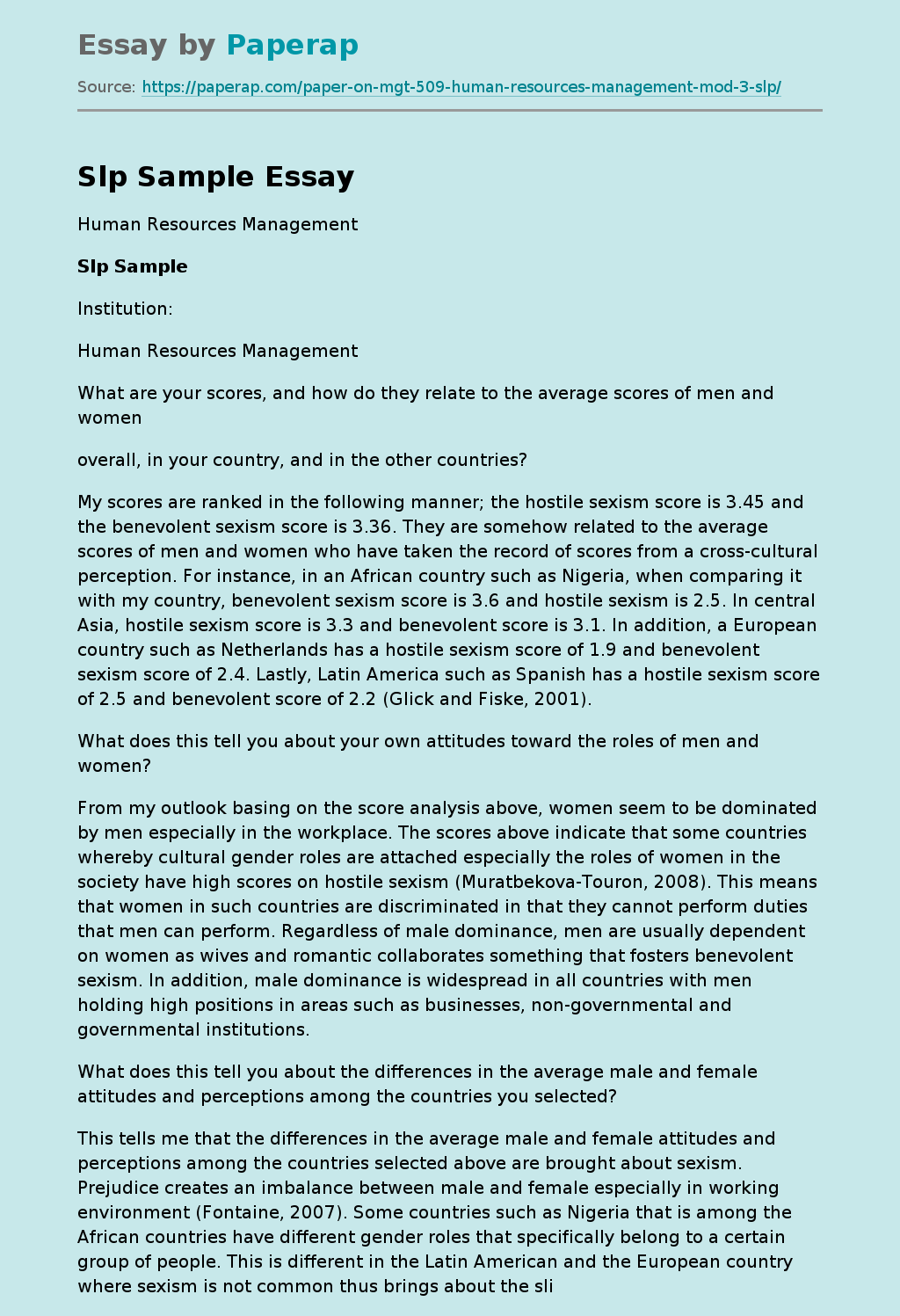HR Management Scores & Gender Comparison
Human Resources Management
Slp Sample
Institution:
Human Resources Management
What are your scores, and how do they relate to the average scores of men and women
overall, in your country, and in the other countries?
My scores are ranked in the following manner; the hostile sexism score is 3.
45 and the benevolent sexism score is 3.36. They are somehow related to the average scores of men and women who have taken the record of scores from a cross-cultural perception. For instance, in an African country such as Nigeria, when comparing it with my country, benevolent sexism score is 3.6 and hostile sexism is 2.5. In central Asia, hostile sexism score is 3.3 and benevolent score is 3.1. In addition, a European country such as Netherlands has a hostile sexism score of 1.9 and benevolent sexism score of 2.4. Lastly, Latin America such as Spanish has a hostile sexism score of 2.5 and benevolent score of 2.2 (Glick and Fiske, 2001).
What does this tell you about your own attitudes toward the roles of men and women?
From my outlook basing on the score analysis above, women seem to be dominated by men especially in the workplace.
The scores above indicate that some countries whereby cultural gender roles are attached especially the roles of women in the society have high scores on hostile sexism (Muratbekova-Touron, 2008). This means that women in such countries are discriminated in that they cannot perform duties that men can perform. Regardless of male dominance, men are usually dependent on women as wives and romantic collaborates something that fosters benevolent sexism.
In addition, male dominance is widespread in all countries with men holding high positions in areas such as businesses, non-governmental and governmental institutions.
What does this tell you about the differences in the average male and female attitudes and perceptions among the countries you selected?
This tells me that the differences in the average male and female attitudes and perceptions among the countries selected above are brought about sexism. Prejudice creates an imbalance between male and female especially in working environment (Fontaine, 2007). Some countries such as Nigeria that is among the African countries have different gender roles that specifically belong to a certain group of people. This is different in the Latin American and the European country where sexism is not common thus brings about the slight difference when comparing the average score.
What insights did you gain through this exercise?
This exercise has helped me to gain knowledge especially on what is being required in order to avoid sexisms. It has enabled me to understand the importance of cherishing and protecting other people in the society. For instance, benevolent sexism sometimes seems to be harmless but we should be careful because it has a devastating effect on the society.
In what ways do you think the inventory might be improved?
The inventory or the above list should be improved through educating people on the importance of creating gender diversification across all sectors in the economy (Hickman, 2011). People should be educated to avoid sexism. In addition, there should be change in leadership restructuring to include all women in various work places as leaders. It should be invented in a way that can eliminate prejudice between male and female. Organizations should embrace uniformity across all sectors to avoid prejudice.
In what ways does this relate to human resource management policies and practices?
This is related to human resource management policies and practices because sexual differences have been used in various organizations to justify the position of men and women in the work place. Many male human resource managers are mostly given the high position or leadership in an organization unlike female counterparts (Shen, Chanda, Netto and Monga, 2009). The research carried out in the United States indicates that women in most societies do not enjoy the same opportunities as men. In organizations such as business entities, women are discriminated based on sex. The research indicates that the numbers for men outdo that of women in occupations such as the senior financial management or other resources management.
References
Fontaine, R. (2007). Cross-cultural management: six perspectives. Cross Cultural
Management: an International Journal, 14, 2, 125-135.
Glick, P., & Fiske, S. T. (January 01, 2001). Ambivalent Sexism – III Measuring Ambivalent
Sexism: The ASI. Advances in Experimental Social Psychology, 33, 123.
Hickman,C. (2011). Diversity in Organizations. Retrieved on May 23, 2011 from
http://ezinearticles.com/?Diversity-in-Organizations&id=166950
Muratbekova-Touron, M. (2008). From an ethnocentric to a geocentric approach to IHRM: The
case of a French multinational company. Cross Cultural Management, 15, 4, 335-352.
Shen, J., Chanda, A., Netto, B., & Monga, M. (2009). Managing diversity through human
resource management: an international perspective and conceptual framework. International Journal of Human Resource Management, 20, 2, 235-251.
HR Management Scores & Gender Comparison. (2019, Dec 05). Retrieved from https://paperap.com/paper-on-mgt-509-human-resources-management-mod-3-slp/

